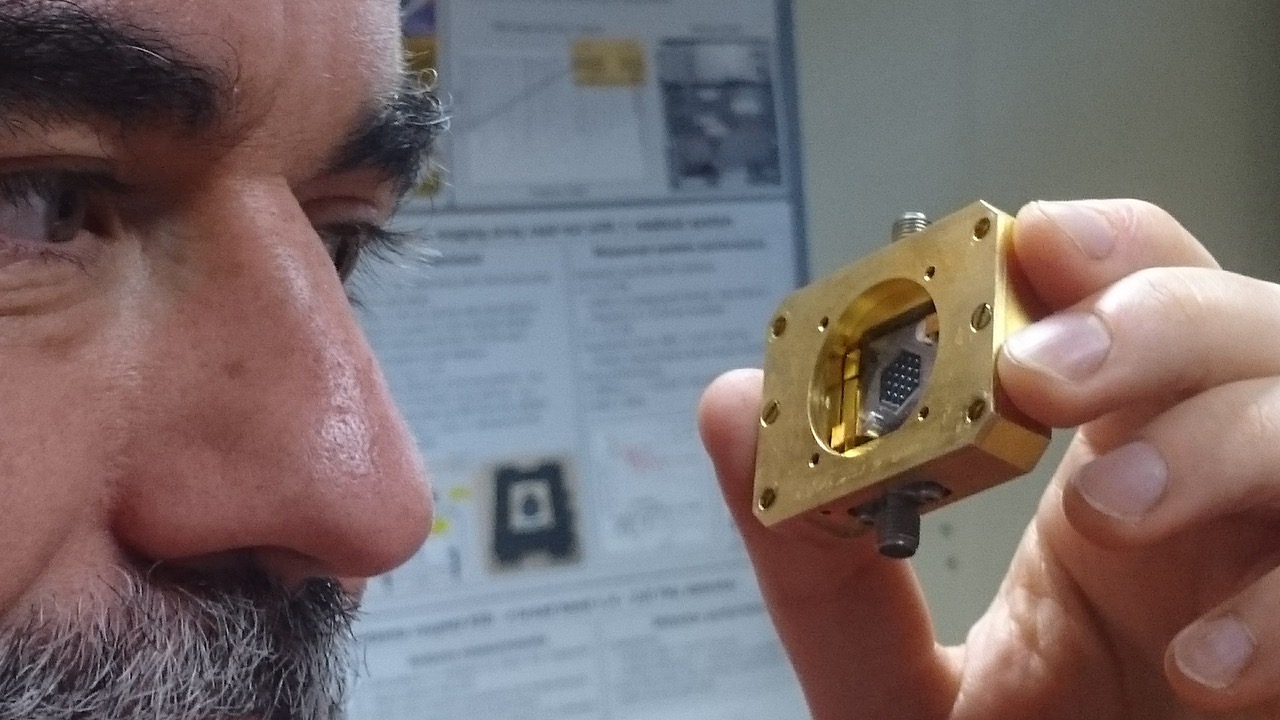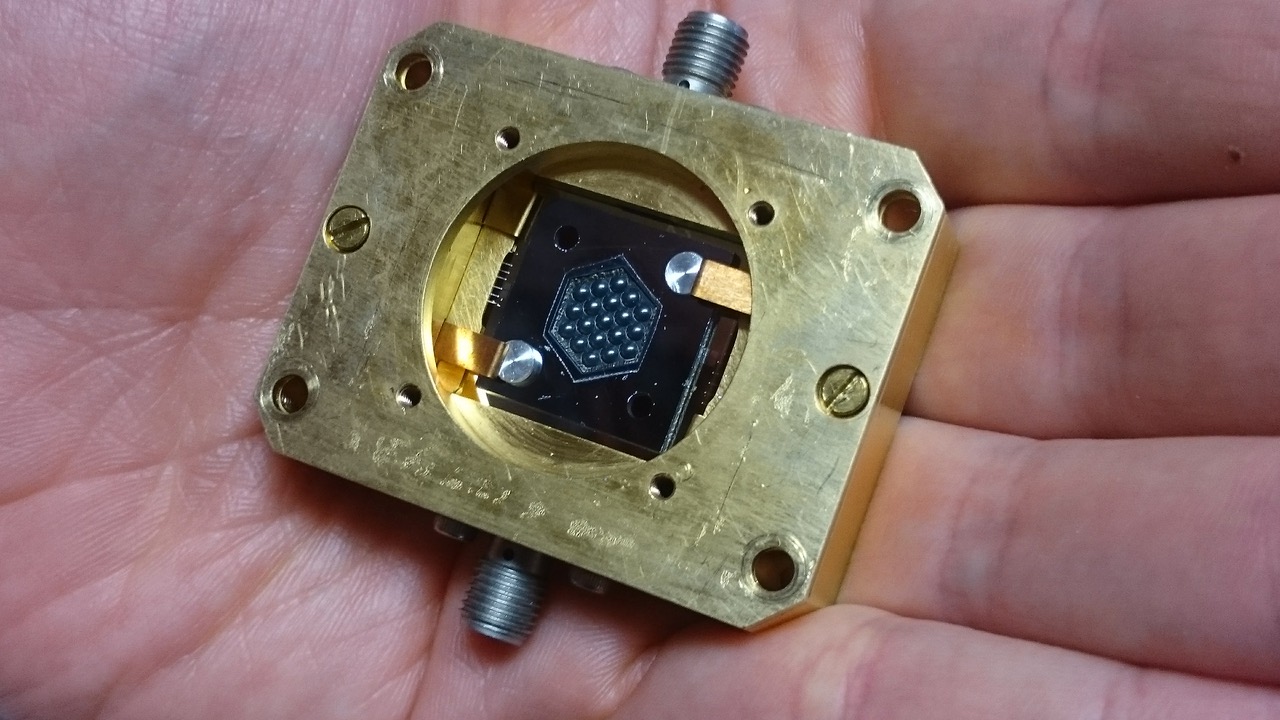Researchers at SRON and Delft University of Technology have doubled the sensitivity of a detector for a far-infrared camera. With this, they have once again realized a breakthrough in the development of an efficient space camera for studying the early and cold universe.
 Juan Bueno (SRON) and the dual polarized antenna coupled KID detectors with which he performed the measurements. Photo: Renske van den Berg
Juan Bueno (SRON) and the dual polarized antenna coupled KID detectors with which he performed the measurements. Photo: Renske van den BergBy measuring two polarizations (vibrational directions) of a signal with a single detector, twice as much energy can be measured. This is a crucial step in making a space camera far more sensitive, for a part of our universe that has scarcely been disclosed yet.
Old weak radiation
Electromagnetic radiation from the early universe is extremely weak but still reaches us in the form of far-infrared radiation. About half of all energy from the universe reaches us via far-infrared radiation. In the far-infrared spectrum, the bandwidth with wavelengths of 0.03 to 1 millimeter is generally referred to as the Terahertz frequency range. It is a rich source of astronomical information. However, until a sensitive broadband camera for this bandwidth becomes available, the remote sources of this type of weak signal, such as the very first galaxies, will remain practically invisible. That is a shame because they contain a lot of information about the evolutionary history of the universe. Astronomers around the world are eagerly awaiting a sensitive Terahertz camera that has many pixels and which will be positioned in space so it is not affected by the Earth’s atmosphere.
Two polarizations for the price of one
SRON and Delft University of Technology have developed Kinetic Induction Detectors (KIDs) intended for such a sensitive camera. A KID is extremely sensitive to far-infrared light. The researchers face three challenges: increasing the detectors’ sensitivity, ensuring that each detector can measure a considerable bandwidth, and finally shifting the frequency measurements towards the area above 1 THz. That area is difficult to measure, but it contains a wealth of astronomical information that we cannot easily access yet.

To achieve that goal, the researchers changed the design of their KID with coupled antenna in such a way that it can measure not one but two polarizations from the incoming radiation simultaneously. With a single KID detector, the researchers from SRON Utrecht and Groningen, and Delft University of Technology were now able to measure twice as much energy as they could with previous KID detectors. “And that is an awful lot if you want to measure something that has such low energy as the cosmic signals that we want to measure”, says SRON researcher Jochem Baselmans.
Besides the double quantity of energy that the researchers have measured, the measurement was also made in a bandwidth range around 1.55 Terahertz, and so in the ‘more difficult’ part of the spectrum.
Antennae that make the detectors directional are embedded in the detectors under a minuscule silicon lens. That enables the detectors to measure a broad frequency range and facilitates the future efficient use of multiple KIDS in an array for a camera, an application already demonstrated by the researchers with a previous generation of KID detectors.
At the end of October, the researchers published an article about the functioning of their dual polarized KID detector in the leading journal for Terahertz science and technology: IEEE Transactions on Terahertz Science and Technology.
For the next step of making KID systems fit for use in space, SRON and Delft University of Technology are working together in an international consortium of research groups on the project Spacekids.
The research described in this article was funded from this program and from grants that researchers Jochem Baselmans (SRON & Delft University of Technology) and Nuria Llombart (Delft University of Technology) received from the European Research Council (ERC).
Weer grens verlegd voor ver-infraroodcamera in de ruimte
Onderzoekers van SRON en TU Delft hebben een detector voor een ver-infraroodcamera twee keer zo gevoelig gekregen. Daarmee hebben zij weer een grens doorbroken in de ontwikkeling van een efficiënte ruimtecamera voor bestudering van het prille en koele heelal.

Door met één detector twéé polarisaties (trillingsrichtingen) te meten van een signaal, meet je twee keer zoveel energie. Dat is belangrijk voor het vele maken gevoeliger maken van een ruimtecamera, voor een nog maar mondjesmaat onthuld deel van ons universum.
Oude zwakke straling
Elektromagnetische straling uit het prille heelal is extreem zwak, maar bereikt ons nog steeds, in de vorm van ver-infrarood straling. Ongeveer de helft van alle energie uit het universum bereikt ons als ver-infrarood straling. Het gebied daarbinnen met golflengtes van 0,03 tot 1 millimeter wordt meestal aangeduid als het Terahertz frequentiegebied.
Dit gedeelte van ver-infrarood is rijk aan astronomische informatie, maar zolang een gevoelige breedbandcamera voor deze bandbreedte er nog niet is, blijven de verre bronnen van dit soort zwakke signalen, zoals de allereerste melkwegstelsels, nog altijd niet of onvoldoende zichtbaar. Dat is jammer, want zij bevatten veel informatie over de ontstaansgeschiedenis van het universum. Astronomen wereldwijd kijken vol verwachting uit naar een gevoelige Terahertz camera met veel pixels in de ruimte, waar de aardatmosfeer de camera niet in de weg zit.
Twee polarisaties voor de prijs van één
SRON en TU Delft ontwikkelen met het oog op zo’n gevoelige camera Kinetische Inductie Detectoren (KID’s). Een KID is namelijk extreem gevoelig voor ver-infrarood licht. De onderzoekers staan voor drie uitdagingen: het gevoeliger maken van de detectoren, het zorgen dat elke detector een flinke bandbreedte kan meten en tenslotte het opschuiven van de frequentiemetingen richting het moeilijkere meetbare gebied bóven de 1 THz. Want dat is juist zo rijk aan sterrenkundige informatie waar we nog niet goed bij konden.

Om dat te bereiken veranderden de onderzoekers het ontwerp van hun KID-met-gekoppelde-antenne zodanig, dat het van invallende straling niet één, maar twéé polarisaties in één keer kan meten. Met één KID-detector pikten de onderzoekers uit Utrecht, Groningen en Delft van SRON en TU Delft nu twee keer zoveel energie op als met eerdere KID-detectoren. “En dat is heel veel als je iets wilt meten dat zo een ontzettend lage energie heeft als de kosmische signalen die we straks willen meten”, aldus SRON-onderzoeker Jochem Baselmans.
Behalve de dubbele energie die de onderzoekers hebben gemeten, betrof het ook een meting in een bandbreedtegebied rond 1,55 Terahertz, dus in het ‘lastigere deel’ van het spectrum.
Antennes die de detectoren richtingsgevoelig maken, zijn ingebed in de detectoren zelf, onder een piepklein siliconen lensje. Zo kunnen ze een brede frequentieband aan en zijn ze straks efficiënt toepasbaar met meerdere tegelijk in een array voor een camera, zoals voor een vorige generatie KID-detectoren al door de onderzoekers is aangetoond.
De onderzoekers publiceerden de werking van hun duaal gepolariseerde KID-detector eind oktober in het wereldwijd toonaangevende vakblad over Terahertzwetenschap en -technologie: IEEE Transactions on Terahertz Science and Technology.
Voor de stap naar ruimtebestendige KID-systemen, werkten SRON en TU Delft samen in een internationaal consortium van onderzoeksgroepen, project Spacekids.
Het bovenstaande onderzoek is bekostigd uit dit programma en uit de beurzen die onderzoekers Jochem Baselmans (SRON & TU Delft) en Nuria Llombart (TU Delft) ontvingen van de European Research Council (ERC).


